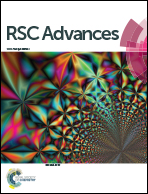Theoretical insights into the CO dimerization and trimerization on Pt nanocluster†
Abstract
CO dimerization and trimerization on an icosahedral Pt55 cluster were investigated using density functional theory. It is found that the products of CO polymerization depend on the different active sites of the metal surface and CO coverage. C2O2 can be adsorbed on either two neighboring Pt atoms or one Pt atom, and the former case is preferred. The preference can be ascribed to the stronger interaction between the 8σ orbital of C2O2 and 5d orbitals of Pt in the former case, and this interaction increases the stability of C2O2. Two neighboring adsorbed CO molecules (CO*) can capture one free CO to form a ring-opening CO trimer on the Pt surface. High CO coverage can facilitate the dimerization and trimerization of CO and change the preferred adsorption site of C2O2, and highly-coordinated Pt atoms present the superior chemical activity for CO polymerization at high CO coverage. The CO dimerization by two CO* need to overcome a high energy barrier of 1.92 eV, but one CO* can capture one free CO molecule to form the C2O2 with overcoming a much lower energy barrier of 0.87 eV. The energy barrier of CO trimerization is 1.14 eV.


 Please wait while we load your content...
Please wait while we load your content...